#northeastern us culture is getting iced drinks all year
Explore tagged Tumblr posts
Text

A Snowy Walk Home
Realizing I never posted my new fursona here?? What?? I guess you see them as a taur before their normal form...
#emerald art#described#2024#furry art#taur#lynx#yes the boba is iced#northeastern us culture is getting iced drinks all year
38 notes
·
View notes
Text
Why are Thailand’s roads among the deadliest in the world?

The Thai woman was riding on a motorcycle on her way to work when a pickup truck sideswiped her on a rural stretch of asphalt in northeastern #Thailand. The truck’s driver was an off-duty police officer. He was drunk.
Orathai Chanhom, the motorcyclist, was catapulted off her bike and killed almost instantly in the crash. The officer who struck her still has his police job. His driver’s licence was not taken away. A court declined to sentence him to prison. In Thailand, one of the world’s most unequal societies, even its roads have a rigid hierarchy, with the poor far more likely to be killed in accidents than the well-off and well-connected. And there are many deaths: Thailand had the world’s second-highest rate of road fatalities per capita, surpassed only by war-afflicted, lawless Libya, according to a 2015 report from the World Health Organisation (WHO). When it comes to per-capita motorcycle deaths, the country is number one. The government vowed at a United Nations forum in 2015 to halve the number of road traffic deaths by 2020. With less than one year to go before the deadline, however, Thailand is a long way from fulfilling that promise, its roads still ranking among the world’s 10 most dangerous, with more than 20,000 preventable fatalities a year. The country has seen a small dip in road deaths since 2015, and Thailand has in place many of the necessary laws to make its roads safer. But what the government has not addressed is the country’s vast gap in wealth, which is the core issue that not only makes its roads so deadly, but has also split the country into two bitterly divided political camps: Thailand’s haves and have-nots. Thailand, named the most unequal country of the 40 major economies surveyed last year by Credit Suisse, has what might be the world’s most toxic combination for traffic safety. Unlike poorer countries, its roads are well paved and made for speed, and the cars driven by the rich and its growing middle class tend to be new and fast. https://bangkokjack.com/2019/08/12/thailand-reduce-road-accidents-aim/ But many Thai families can only afford a single scooter or motorcycle, and high-quality helmets are a luxury for many, whatever the law says about them being mandatory to wear. In accidents on the country’s crowded roads, it’s a devastating mismatch when an air-conditioned SUV collides with a two-wheeler, scattering the detritus of death across the asphalt. And the aftermath of such accidents are a common, macabre sight on Thai thoroughfares: a shredded tyre, a mangled frame of steel, a bloody plastic flip-flop. Motorcycle accidents can involve a number of fatalities. Because public transportation is limited outside the big cities, it’s not uncommon to see a couple of adults – and even a child or two crammed between them – balanced on a single bike. Only 12 per cent of Thailand’s road traffic deaths involved occupants of cars or other light vehicles, according to the 2018 WHO Global Status Report on Road Safety. Most of the dead were motorcyclists – or pedestrians. In many Thai towns, there are few wide, easily usable pavements because, critics say, they are not a priority for the rich and influential, who prefer not to walk in Thailand’s oppressive heat. When there are wide footpaths, they often overflow with street stalls and even motorcycle traffic, pushing people into the roads. The country’s economic disparity is not the only reason Thailand’s road deaths are not distributed equally. Justice, too, is handed out unevenly. For the super rich, or those in positions of authority, the rules of the road may not apply at all. They know they can speed with impunity and drink heavily before getting behind the wheel, with little fear of the consequences. In 2012, a young man in a Ferrari – the heir to the Red Bull energy drink fortune – allegedly ploughed into a policeman, dragging him to his death. The driver, Vorayuth Yoovidhya, was intoxicated, according to a test. Seven years later, he has never been prosecuted. “What is clear in Thailand is that the roads are not safe for all users,” says Evelyn Murphy, who specialises in unintentional injury prevention at the WHO. “Whether it’s cars or motorcycles or pedestrians, the safety of all users of roads must be considered, regardless of income level.” https://bangkokjack.com/2020/02/29/thailands-roads-deadliest-world/ Weak enforcement, compounded by corruption Speeding, drunken driving and failing to wear proper helmets are the primary causes of traffic deaths in the country, Thai officials say. While the laws are there to combat each of those factors, enforcement is not. Wearing helmets is required on two-wheelers, but fines are rarely issued, unless the police need to meet a specific quota during a crackdown period. Unaccustomed to checkpoints or sirens, speeders or other rule-breakers may not even pull over when caught. “It’s hard to convince people to stop for us when they are not used to stopping,” says Jirasunt Kaewsaengeak, the deputy commissioner of the Bangkok Metropolitan Police. Then, there is corruption. The rich or well-connected know a bribe can often see them on their way if they are nabbed breaking traffic laws. Bangkok’s 3,000 traffic police make an average of £500 a month for working in broiling heat, monsoonal downpours and suffocating smog, which can make even small payoffs highly appealing, and effective. Twice a year, during the Thai new year in April and the western new year in January, campaigns warn against drunken driving, complete with billboards of gory crashes. Arrests skyrocket during these periods, but then quickly fall off again. “If you eat vegetables twice a year and only eat ice cream for the rest of the year, your doctor will think you are crazy,” says Tairjing Siriphanich, the secretary-general of the Don’t Drive Drunk Foundation of Thailand. “But that’s what we are doing with road safety.” A ‘sabai sabai’ mindset When asked why so many people die on Thai roads, officials here ascribe it to a “sabai sabai” culture. Sabai sabai is one of those untranslatable phrases, but it denotes a kind of relaxed contentment. Sabai sabai is one reason Thailand is a great place for a beach holiday. But it’s not a helpful attitude when building national safety standards. “If police enforce the law, rather than just give a verbal warning, then Thai people are unhappy, and they complain that it’s not sabai sabai,” Jirasunt says. A prime example of the effect of the sabai sabai way of life on traffic safety is the approach to helmets. Many motorcyclists simply don’t bother. “People think air pollution is a threat, but they don’t think the same way about drunken driving or wearing helmets,” says Tairjing of the Don’t Drive Drunk Foundation. “We have failed to make people understand that they can save their own lives.” But the authorities can make a difference: in the districts where police are known to hand out fines, helmets are more common. The government could also do more to educate Thais about helmets, which are often substandard or worn incorrectly. “When you see someone who makes the effort to put on a helmet without actually strapping it on, it defeats the whole purpose of wearing it,” says Murphy of the WHO. “It shows a lack of understanding of basic safety mechanisms.” https://bangkokjack.com/2020/02/18/fewer-road-deaths-songkran/ Shifting the blame In 2016, 32.7 out of every 100,000 Thais died on the country’s roads, according to the most recent WHO estimates. By comparison, the road fatality rate in the United States was 12.4 that year. In Indonesia, a less-developed southeast Asian country with more potholed roads, the rate was 12.2. Across most of Europe, it was a single-digit number. Since the government made its promise to halve road deaths, a vow other countries have also made, Thailand has barely inched upwards, moving from the country with the next-to-worst per-capita death tally to the ninth worst. “No political party has made this an issue. No leader wants to do anything,” Tairjing says. “They just make promises to halve the number of road deaths even though they know it’s impossible. Maybe they think we’ll forget about the promises they made.” The question of who is at fault for Thailand’s lack of progress draws a lot of finger pointing by Thai officials. Chayatan Phromsorn, the deputy director-general of the Office of Transport and Traffic Policy and Planning, the agency that pledged to the United Nations to halve the number of road deaths, said he was not familiar with the document that detailed Thailand’s promise. (That English-language document was never made available online in Thai script.) The official who presented the paper to the United Nations in 2015 said she had done so only because her colleague was unable to attend the conference. In turn, that colleague, Usanisa Jikyong, said in an email that her office “is not responsible for a road safety initiative in the national level”. Usanisa suggested that another government agency, the department of disaster prevention and mitigation at the Ministry of Interior, was in charge of such matters. But Chayabol Thitisak, the department’s director general, shifted responsibility back to Usanisa’s office. Officials at both agencies said that the blame lay primarily with the police. “The big factor is law enforcement,” Chayabol said. “We have to make people realise that by violating the law they will face severe consequences.” But the police refuse to accept fault. “As police, there are many things we cannot do,” Jirasunt says. “We cannot build more roads and public transportation. We cannot change the number of cars on the road. We cannot change the attitudes of people so they have discipline.” The high human cost The World Bank estimated in a 2018 study that Thailand could lift its per-capita gross domestic product by 22 per cent by the year 2038 if it successfully halved its traffic fatalities. Despite that economic upside, the government – led by a retired military general since a 2014 coup – has done little to address the wealth gap that’s at the core of Thailand’s problem with road deaths. The country has made a few road-safety improvements. Schools have added road-safety lessons to their curriculums, and there has been some progress in setting new vehicle safety standards. The numbers do show a slight improvement: road deaths were 7 per cent lower in 2018, with 22,491 deaths compared with 24,237 in 2015. While the enormous macroeconomic cost of all these road deaths can be measured, what can’t be given a money figure is the personal toll inflicted on individuals by the inequality and impunity that menaces Thailand’s roads. The family of Orathai, the killed motorcyclist, has no lawyer to pursue a civil claim. It did not appeal the decision not to jail the officer. There is no further legal action to take. “In Thailand, the law does not matter,” says Chularat, her daughter. “People like us, how can we change anything? Even if we die for no reason, our lives are worthless.” For the poor, Thailand’s roads are unsafe at any speed. – You can follow BangkokJack on Twitter, Instagram, & Reddit. Or join the free mailing list (top right) Please help us continue to bring the REAL NEWS - PayPal Read the full article
0 notes
Text
Thai cooking places accentuation on delicately arranged dishes with strong aromatic components and a fiery edge.Thai sustenance as illustrating “multifaceted nature; meticulousness; surface; shading; taste; and the utilization of fixings with therapeutic advantages, and additionally great flavor”, and in addition mind being given to the nourishment’s appearance, smell and setting.
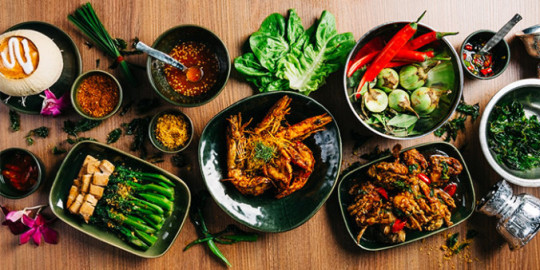
Thailand was a cross streets of East to West ocean courses making its way of life and food be implanted with Persian and Arabian components. Remote formulas have been coordinated with customary Thai dishes, bringing about one of a kind flavor that is unmistakably Thai.
The ‘Tai’ individuals moved from valley settlements in the sloping locale of Southwest China (now Yunnan area) between the 6th and thirteenth hundreds of years, into what is presently known as Thailand, Laos, the Shan States of upper Burma, and northwest Vietnam. Impacted by Chinese cooking procedures, Thai food thrived with the rich biodiversity of the Thai promontory. Accordingly, Thai dishes today have a few similitudes to Szechwan Chinese dishes.
Thai cooking is all the more precisely depicted as five territorial foods, comparing to the five fundamental areas of the nation:
Bangkok food of Bangkok and Metropolitan zone, above all else cooking base on Chinese and Portuguese impact.
Focal Thai food of the level and wet focal rice-developing fields, site of the previous Thai kingdoms of Sukhothai and Ayutthaya, and the Dvaravati culture of the Mon individuals from before the entry of Tai gatherings in the region.
Isan or northeastern Thai food of the more parched Khorat Plateau, comparative in culture to Laos and furthermore impacted by Khmer cooking to its south, as confirm by the sanctuary ruins from the season of the Khmer Empire.
Northern Thai food of the verdant valleys and cool, forested piles of the Thai good countries, once managed by the previous Lanna Kingdom and home to most of the ethnic gatherings of Thailand.
Southern Thai food of the Kra Isthmus which is verged on two sides by tropical oceans, with its numerous islands and including the ethnic Malay, previous Sultanate of Pattani in the profound south.
Meals in Thai food
1 Tom Yum Goong (Spicy Shrimp Soup)
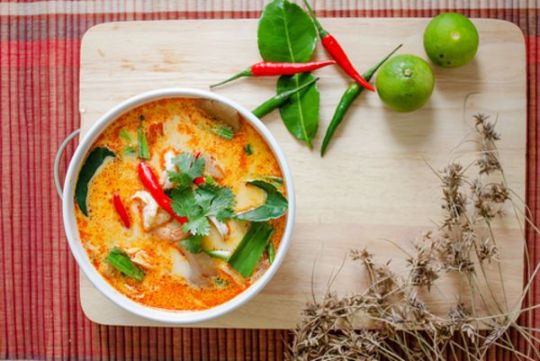
The quintessential Thai smell! An intense, reviving mix of fragrant lemongrass, stew, galangal, lime leaves, shallots, lime squeeze and fish sauce shapes this exemplary soup, giving it its unbelievable home grown kick. Succulent new prawns and straw mushrooms loan it body. A flexible dish that can fit inside for all intents and purposes any feast, the particular scent helps you to remember extraordinary fragrance, while it’s strengthening harsh fiery hot taste just shouts ‘Thailand’!
2 Som Tum (Spicy Green Papaya Salad)
Hailing from the Northeast province of Isaan, this shocking dish is both incredible divider – some can’t get enough of its nibble, some can’t deal with it – and extraordinarily unmistakable. Garlic, chilies, green beans, cherry tomatoes and destroyed crude papaya get drastically pummeled in a pestle and mortar, so discharging an adjusted sweet-harsh zesty flavor that is not effortlessly overlooked. Territorial varieties toss peanuts, dry shrimp or salted crab in with the general mish-mash, the last having a gut-purifying ability that gets numerous newcomers off guard!
3 Tom Kha Kai (Chicken in Coconut Soup)

A mellow, more agreeable curve on Tom Yum, this notable soup injects blazing chilies, daintily cut youthful galangal, squashed shallots, stalks of lemongrass and delicate portions of chicken. However not at all like its more watery cousin, lashings of coconut drain diminish its zesty blow. Finished off with crisp lime leaves, it’s a sweet-noticing mixture, both smooth and convincing.
4 Gaeng Daeng (Red Curry)
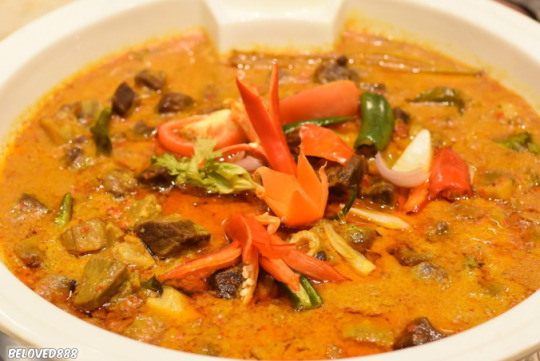
Made with pieces of meat, red curry glue, smooth coconut drain and finished off with a sprinkling of finely cut kaffir lime leaves, this rich, fragrant curry dependably gets those taste buds shivering. Getting it done when the meat is stunningly delicate, it could be compared to a lovely lady: it’s mellow, sweet and carefully fragrant. What’s more, similar to all genuine romance issues, nonappearance influences the heart to become fonder.
5 Pad (Thai style Fried Noodles)

From Cape Town to Khao San Road, the default global Thai dish! Dropped in a burning hot wok, fistfuls of little, thin or wide noodles (you pick) do a hot moment long move close by crunchy beansprouts, onion and egg, before landing for the closest plate. A genuinely intelligent eating knowledge, a large portion of its fun (and flavor) lies in then utilizing a group of four of going with toppings – angle sauce, sugar, stew powder and finely ground peanuts – to wake it from its sleeps.
6 Khao Pad (Fried Rice)

Fried rice, egg, onion, a couple of herbs – nothing all the more, not much. A mainstream lunch dish served ordinarily with a wedge of lime and cuts of cucumber, the mystery of this honest dish lies in its straightforwardness. The idea is this: you’re the one eating up it, so you dress it. To do as such, Thais utilize everything from prawns, crab or chicken to basil, bean stew and left-finished vegetables, in the process transforming an unremarkable homeless person into a gastronomic sovereign!
7 Pad Krapow Moo Saap (Fried Basil and Pork)

An amazingly mainstream ‘one plate’ dish for lunch or supper, browned basil and pork is positively a standout amongst the most famous Thai dishes. It is made in a steaming wok with loads of sacred basil leaves, expansive crisp stew, pork, green beans, soy sauce and a little sugar. The minced, greasy pork is slick and blends with the steamed white rice for a dazzling satisfying supper. It is frequently finished with a fricasseed egg (kai dao) you will no doubt be inquired as to whether you might want an egg with it. Know that most Thai individuals request bunches of stew in this dish so in the event that you are not a fanatic of shivering lips, request you cushion krapow ‘somewhat fiery’.
8 Gaeng Keow Wan Kai (Green Chicken Curry)
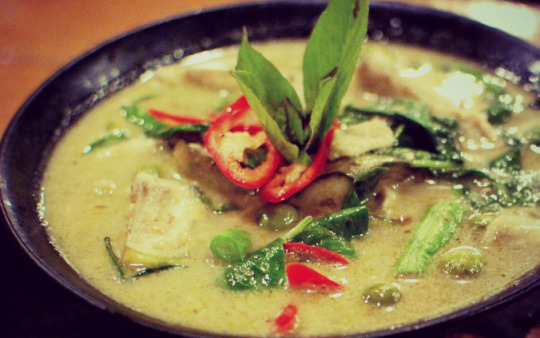
Morsels of crisp chicken. Cherry-sized eggplants. Delicate bamboo shoots. Sprigs of Coriander. Liberal modest bunches of sweet basil. These modest components shape the body of this original curry. Be that as it may, how can it get so brilliantly green you inquire? Gracious, that’ll be the spoons of green curry glue that is blended irately into hot velvety coconut drain. Served close by a bowl of fragrant Thai rice, Gaeng Keow Kan Gai is the extraordinary inverse.
9 Yam Nua (Spicy Beef Salad)
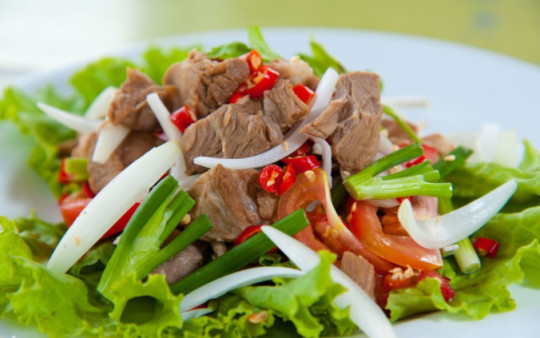
If there was such an unbelievable marvel as a ‘Plate of mixed greens Hall of Fame’, Thailand’s lively claim breed, or ‘yam’ as they are known here, would without a doubt assume pride of position. Unconvinced? Experience the new, blazing rush of yam nua – with its buoyant blend of onion, coriander, spearmint, lime, dried bean stew and delicate pieces of meat – and you won’t be. It splendidly epitomizes the animating in-the-mouth-excite of every Thai serving of mixed greens, the yummy-ness of yam.
10 Kai Med Ma Muang (Chicken with Cashew Nuts)

Pardon the joke, yet sightseers go crazy for this blend browned dish. Maybe it’s the fiercely differentiating surfaces of a dish that saut’s chicken close by broiled cashews, sweet soy sauce, onions, chilies, pepper, carrot and mushrooms. Maybe it’s the sweetening dash of nectar that interests. Do you truly mind? The imperative thing is that this dish works: it’s basic however delicious, somewhat agreeable yet still absolutely Thai.
Beverages
Cha yen – Thai frosted tea.
Krating Daeng – a caffeinated drink and the starting point of Red Bull.
Nam maphrao – the juice of a youthful coconut, frequently served inside the coconut.
Nam matum – an invigorating and sound drink produced using the product of the Bael tree.
Oliang – a sweet Thai dark frosted espresso.
Satho – a customary rice wine from the Isan locale.
Nam bai bua bok – A reviving and solid drink is produced using the green leaf of the Centella asiatica.
Other alcoholic beverages from Thailand incorporate Mekhong whisky and Sang Som. A few brands of lager are fermented in Thailand, the two greatest brands are Singha and Chang
Insects
Certain bugs are additionally eaten in Thailand, particularly in Isan and in the north. Many markets in Thailand highlight slows down which offer broiled grasshoppers, crickets (ching rit), honey bee hatchlings, silkworm (non mai), insect eggs (khai quip) and termites. The culinary innovativeness even stretches out to naming: one delicious hatchling, which is additionally known under the name “bamboo worm” (non mai phai, Omphisa fuscidentalis), is conversationally called “express prepare” (spoil duan) because of its appearance
Sweets
Mango layer cake

This mango cake formula is so crisp, fleecy and scrumptious, in addition to it’s enjoyable to make. In Thailand cakes like this are served at all the enormous lodgings where cooks include fancy trimmings arranged with new mango and coconut. Here I’ve disentangled the procedure while keeping the first taste. Furthermore, what is that? I’d depict it as similar to strawberry shortbread aside from with the outlandish taste of mango.
Mmm Mango Pudding – an extraordinary approach to utilize new summer mangos!

Mangos are in season amid the mid year months, and this pudding is an incredible approach to utilize them. I made it as of late for my relatives from Asia, and they preferred it superior to their most loved mango pudding which they more often than not arrange at a diminish total eatery. What makes it additional great is the way that it is made with coconut drain as opposed to whipping cream or general drain. Dissimilar to dairy items, coconut drain brings out and upgrades the essence of the mango.
Mango Ice Cream, as in Thailand

Attempt this fabulously simple formula for mango dessert as in Thailand! The surface of this solidified pastry is somewhere between sorbet and frozen yogurt, and brimming with mango season. Brisk and easy to make as well, in light of the fact that there’s no stove included – not even a frozen yogurt creator. All you require is a blender or nourishment processor. Makes an excellent treat to serve organization, and simple as well, since you can influence it to well ahead of time.
Thai-style Creme Caramel

A Thai form of the great creme caramel treat that is super-simple to make, liquefy in-your-mouth tasty, and more beneficial than conventional creme caramel! This formula calls for coconut drain rather than cream (coconut drain contains great fats that really bring down your cholesterol), so in case you’re lactose-bigoted, this is a decent treat decision for you. It likewise makes a rich sweet to serve visitors or take to a gathering.
Pineapple Upside-Down Cake with Mango and Caramel!

Envision an exemplary pineapple topsy turvy cake jeweled with bits of mango and bound with caramel sauce – paradise! Enjoyable to make, astounding to eat, this scrumptious cake fulfills everybody extremely. It’s straightforward as well – only 1 cake container and no requirement for icing. I want to serve this cake in the late spring as a result of its tropical suggestions: kinds of coconut, pineapple, and mango. The caramel is a surprising reward, hoisting this cake to the ‘best ever’ status in my family.
Thai Banana-Lychee Dessert

This simple treat just takes minutes to make, however don’t be cheated by its straightforwardness – the taste is so superbly sweet and extraordinary that I think that its addictive! It likewise happens to be inconceivably sound. An incredible approach to go through remaining bananas as well.
Thai Tapioca Pudding (sans gluten/veggie lover)

Here’s a pastry formula that is tropical-delectable, simple, sans gluten and veggie lover as well! When purchasing custard, I like the ‘seed’ custard found in the preparing passageway of most customary general stores. You can likewise purchase ‘pearl custard’ at any Asian supermarket. Custard originates from the cassava plant and is a root vegetable, not a grain (subsequently sans gluten), with some sound unsaturated fats, so you can make the most of your sweet faultless.
Simple Tropical (and Local) Fruit Salad
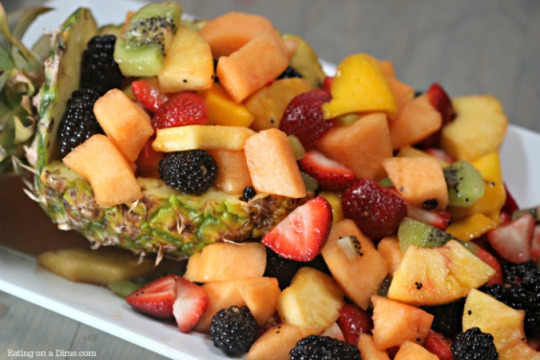
This delightful Thai organic product serving of mixed greens formula is an essence of heaven. Tropical natural product – or a blend of tropical and neighborhood organic product – is prepared together in a sweet coconut-lime natural product plate of mixed greens dressing that upgrades however never overpowers the tasty taste of the organic product. Pick your own mix of neighborhood and intriguing natural product for this simple crisp organic product treat.
Mangosteen Clafouti

Mangosteen is a wonderful Thai organic product that is currently accessible in the US and Canada. Since it contains such a significant number of cell reinforcements, mangosteen likewise offers various medical advantages. In the event that you can’t discover it, lychees make an impeccable substitution and are accessible canned and also new.
Health & Thai food
The blend of herbs and flavors utilized as a part of Thai dishes. These herbs and flavors have ailment battling and safe framework boosting properties.
Here are a few illustrations:
Garlic lessens cholesterol and circulatory strain and it has both anti-infection and contagious properties. It can be utilized to treat hacks and colds and enhances press digestion.
Chillies help the invulnerable framework, ensure heart and clear the sinuses. Red chillies are high in vitamin C.Cumin enhance resistant framework and treat a sleeping disorder, heaps, asthma, bronchitis, respiratory scatters, regular cool, sickliness, skin issue, bubbles and disease.
Ginger,The restorative employments of ginger is practically interminable. Ginger contains chromium, magnesium and zinc which can enhance blood stream. It is likewise enhances retention, anticipates frosty and influenza, diminishes torment and irritation.
Turmeric is an extraordinary calming. It ensures the skin and it has been referred to be utilized as a treatment for dermatitis and other skin issues. Turmeric shields the body from harms. Additionally, turmeric battle against bacterial diseases.
Lemongrass can clear stomach hurts, cerebral pains and counteracts basic icy. It likewise has against contagious properties.
Coriander contains press and both vitamin A, C, K and hints of the B vitamins. It gives high measure of calcium and potassium. Coriander is against septic, pain relieving, assists with absorption, hostile to parasitic and a characteristic stimulant.
“One of the dreams on my wish list is to spend more time in Thailand”
Thai cuisine:A Tourist choice Thai cooking places accentuation on delicately arranged dishes with strong aromatic components and a fiery edge.Thai sustenance as illustrating "multifaceted nature; meticulousness; surface; shading; taste; and the utilization of fixings with therapeutic advantages, and additionally great flavor", and in addition mind being given to the nourishment's appearance, smell and setting.
0 notes
Text
“She Has A Tendency To Pee On Things That Are Older Than America”

Welcome back!
As I type these words, I’m very much in my happy place aboard a TGV flying towards Nîmes from Paris at almost 300 kph (~180 mph), and reminiscing on my past 3ish weeks. Lemme tell y’all, I’ve been just a traveling FOOL, and I’m not mad about it!
There are multiple trips recounted in this, so it’s split into three sections for the three different trips:
Berlin & Hamburg ✔️
Rome ✔️
Rotterdam ⁉️ (yes, I went back again) ✔️
Berlin and Hamburg
So as I said at the end of the previous post, I had planned a trip for me, by me to Germany as a birthday present to myself from, you guessed it, me, but also funded by my loving and incredibly generous parents. This was actually the first journey I’d ever taken completely on my own (apart from, you know, moving across an ocean to a foreign country all alone), and to say that I was nervous would be putting it mildly. I was genuinely scared that spending an entire weekend alone, going to a country I’d never been to before, without anyone who speaks English or French to help me if I get lost...let’s just say that my maternal paranoia (but also, in my case, my sororal paranoia) was kicking in. But, I had already booked the tickets and there were no refunds to be spoken of because lol #ryanair, so I pushed the fears to the back of my mind, and I’m really glad I did: it was an incredibly successful trip!
The journey started off in Toulouse after a train ride that was too early, even for me. Toulouse is a city I’d heard some good things about, and I was glad to be able to check another French city off my list, but I was really only interested in it because there was a makeup store that I’ve wanted to go to for the past couple years—Kryolan. Since I only had a few hours of a layover between train and plane, when I arrived in Toulouse, I wandered around aimlessly for an hour or so, found the makeup shop and got what I needed (banana setting powder, in case anyone was curious) and made my way to the airport.
You are crazy, my child. You must go to Berlin! — Franz von Suppé
Now, I have to say, as excited as I was for this trip as I was planning it, I’m not entirely sure what I was thinking when I decided to go to northeastern Germany in late January, especially after having lived in the south of France for 4 months. It vaguely occurred to me as we were landing that Berlin wouldn’t have the exact same climate as Nîmes, but I was very much unprepared for the gust of actual-winter air that greeted me as I walked off the plane. And what’s worse, there was SNOW. Again, not sure what I was thinking.
All that said, Berlin has definitely been added to my list of favorite cities! I stayed at an Airbnb (well technically it was a “MisterB&B,” which is basically Airbnb, but for gay men 😂 but for all intents and purposes, it was an Airbnb), but I barely spent anytime in the apartment, even though the hosts were very friendly and had ridiculously cute home—one of them was an interior decorator. #fulfillingstereotypes
Anyway, I chose the apartment/MisterB&B because I wanted to experience a city from a “gay” perspective, and the apartment was in the gay district of Berlin, Schöneberg. But when I got to the apartment it was well after sunset (AKA 5:15), so I decided to stay close to home so I could see the rest of the city in the daylight the next day. Schöneberg was still pretty lively when I finally left the apartment to explore. I wandered around the streets for a while, popped into a view stores, and eventually stopped to look at a menu outside of a burger joint that seemed pretty promising. I was just deciding to go in, when I turned to my right, and there was a man straight up staring at me. I quickly realized, however, he wasn’t really staring, but more waiting for me to respond as he had asked me a question that went unheard over the roar of Beyoncé in my ears: he had asked me to grab a drink with him. I contemplated the idea...this was incredibly random and sure enough, I felt my maternal/sororal paranoias coming into play, telling me no, go home, you don’t know him, or where he’s been, or what his motives are... but at the same time, I was very flattered. Isn’t this the kind of thing that happens in movies? Could this man be the man of my dreams? Would we fall in love and live in Berlin and raise babies* together (babies*=puppies)?! My paternal/fraternal “eh, why not?” sense had kicked in and I shrugged and said “Sure! Why not? Free alcohol is not something I’m opposed to!”
His name was Chris, and we walked around until we found a nice bar and we sat and chatted the night away. He was German and actually from Hamburg, in Berlin for work (but don’t ask me what he does, I’m sure I don’t remember.) Anyway, come midnight or so, he decided to call it quits as his train was leaving really early in the morning, and I was falling asleep as it was, having been awake since 4.30 in the morning. Alas, Chris did not turn out to be the man of my dreams, but it was still nice to have some human interaction after traveling alone all day, and I did say I wanted a gay experience, didn’t I? #success. And beyond that, like, how bold of him! I know only like 4 people read this, but how many of you would, if you weren’t married/in committed relationships, walk up to a stranger you found attractive and ask them out? Even though you almost most definitely won’t ever read this, I applaud you, Chris, for your boldness, keep it up and teach it to the world.
But so traveling; Day TWO in Berlin was dedicated to actual, tourist-trap sightseeing. I started out with the Fernsehturm de Berlin, which is a huge TV tower in the city with an observatory at the top that has panoramic views of Berlin. I had planned to do other things before this, but in retrospect, I’m glad I decided to go there first because that line was long, and then once you finally got inside the building from the numbing wind, you were just buying a placeholder to go up to the observatory at least two hours later. It ended up working my favor, though, because after buying the tickets, I made my way to the East Side Gallery, a section of the Berlin Wall that’s still intact and covered in beautiful artwork. Now again, as it was January and also 20º, this particular adventure was mostly “take a picture, admire artwork for 2 seconds, and keep walking before my legs succumb to frostbite” as opposed to actually taking and admiring the artwork.
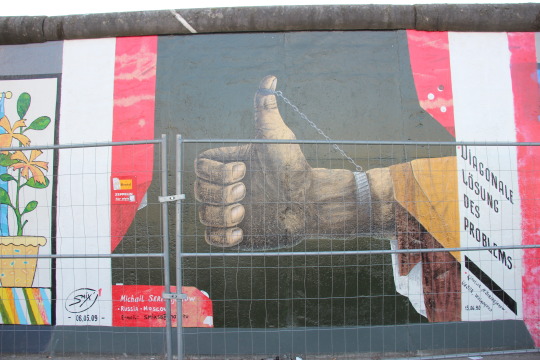


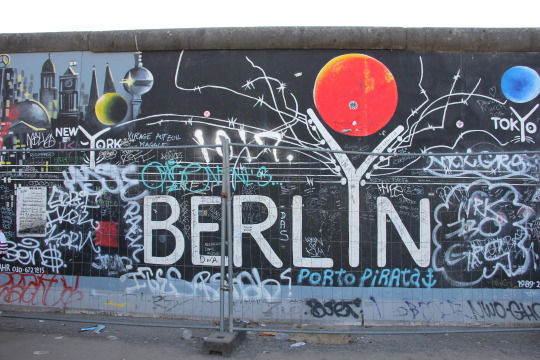
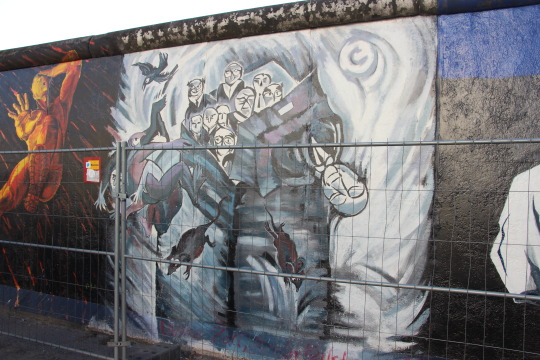
While it might not have been as fulfilling as it could’ve been, it ended up working perfectly because by the time I got back to TV tower, it was time to...wait in another line 🙄 . But it didn’t last long and in no time, I was getting the view of Berlin from the top. Yet again, however, the lack of planning for this trip in terms of the weather/season, coupled with the fact that I went up during sunset, proved to be rather troublesome, and the haze from the setting sun made it incredibly difficult to see the city through the windows of the observatory. I was mildly disappointed after having done all the waiting and whatnot, but, as I looked out over Berlin, I saw a skyscraper facing the TV tower which was clearly sporting an observatory deck, sans windows. I remembered that I had read that there was a hotel that also offered panoramic views of Berlin, but of course, being myself, after reading about it, I promptly forgot. So I made my way down from the top of the TV tower—which was good timing anyway as most of the children up there had been given entirely too much liberty from their parents—and ascended the top of the hotel, and caught some absolutely gorgeous shots of Berlin with the setting sun. I’m never one to brag about my photography skills (especially not landscape photography), but I was really proud of these shots!
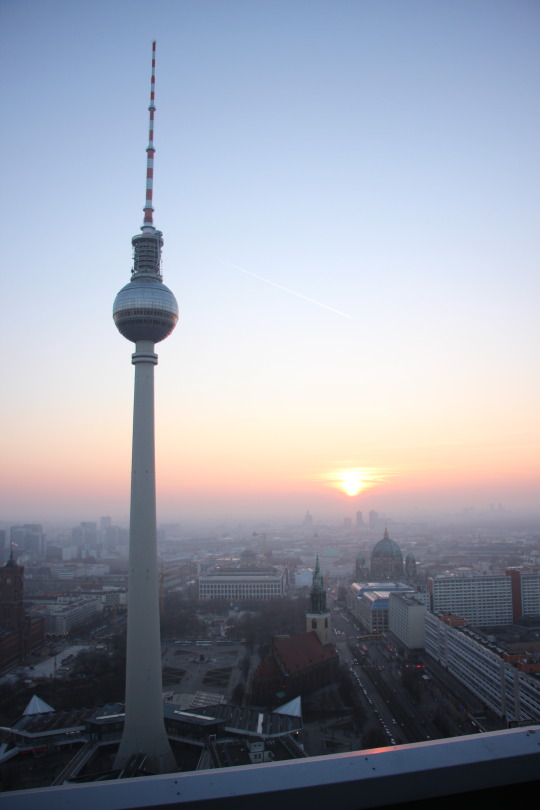

So, alas, the sun had set, and so had the temperature by what felt like 10ª, so it was time for me to no longer be outside.
Over the past few years, I had gone back and forth about getting a tragus piercing (fyi: a tragus is that funny little nubbin of cartilage toward the front of your ear) because it’s small, cute (and also not my earlobe since that trend has definitely ended). Once I finished taking pictures on the top of the hotel, I decided, spur of the moment, that this would be the trip to do it because it was the first trip I’d made solo and wanted to do something to remember it, so why not? Coincidentally, as I was meandering through Schöneberg that first night, I stumbled upon a piercing parlor, and figured it would be perfect, especially since it was in the gay district. When I got there I talked to the man in the parlor about what the whole process would be, and I quickly gathered that he was American. We of course had to chitchat for awhile about what brought us to Europe, our thoughts about the different cultures, blah blah blah and 30 minutes later, I had my ear pierced! Woo! It wasn’t nearly as painful as I thought it might be, and the worse part of the whole process actually ended up being the fact that I could hear the needle going through my cartilage with two little pops. *shivers* But it was done! I’m really happy with it, I think it adds just the right amount of extra flare to my style.
So the next day, Day 3 in Germany! I traveled to Hamburg, and I of course decided to take the ICE train (which is basically the German version of the TGV), and needless to say I was fangirling the whooooole time. But then, after I boarded, to my own surprise, I slept through the entire journey...😐 . I was thoroughly shocked when I woke up to realize that we had arrived. But, oh well, it’s still another famous train ticked off my list!
Now Hamburg was a part of this adventure I was particularly worried about because in addition to the whole traveling alone thing, it would be my first time staying in a hostel and sharing a room with up to 5 other random humans, and those who know me well enough know that I am not very fond of other humans in my day-to-day life. That being said, I made a really good connection while I was there: When I entered the room, heart pounding, fully expecting to see some gross man cutting his yellowing toenails on the floor, instead there was a girl sitting in the windowsill on the phone and speaking American English. Once she hung up, we instantly started chatting about this and that, and I learned that her name is Daunt’e and that thanks to being a military brat, she had traveled quite literally all over the planet, and was in the process of traveling for another 3 months, just cuz. Needless to say, we had plenty to talk about. We walked around Hamburg for a few hours and then grabbed some burgers at a restaurant called Burgerlich which, in addition to being delicious, was super innovative because you did everything, from ordering your food to getting more napkins, with iPads that came out of the top of the table. We ate and drank and continued our chit chats until it was time for me to go to the place that was, if I’m being honest, the entire reason for this trip to Germany:
Miniatur Wunderland: The World’s LARGEST Model Railroad.
—NOBODY PANIC, I KNOW IT’S EXCITING, BUT I NEED EVERYONE TO CALM DOWN—
Okay, so once I got all the voices in my head to chill, I basically ran to this place and even with the hype I’d heard (hype I’d heard from, again, the voices in my head), this place was so far beyond what I could have expected.
It. Was. Incredible.
When you first walked in, you were greeted with a wall full of TVs each displaying one section of the layout, and a few guys sitting in front of what looked like incredibly intense control boards. Once past the TVs, I realized that they divided the layout into different sections based on countries or regions. They had Germany, America, Scandinavia, Switzerland, Italy and a few other places. As you walked along, you saw the different trains (duh), landscapes, architecture, culture, you name it, it was there, of each region. They had wide, open fields, an absolutely enormous replica of the Alps that was well over 10 feet tall, they even had actual water with an ACTUAL CRUISE SHIP THAT ACTUALLY MOVED AND TURNED BY ITSELF TO AND FROM AND IN AND OUT OF THE PORT; they had the mountains of the Western USA and in every region there was just...an almost painful, annoyingly precise attention to detail. Every. Single. Aspect. of Every. Single. Region was thought of and executed perfectly. They even had cars and buses and trucks that drove along the road BY THEMSELVES. They had working stoplights at which the various vehicles would stop, while using their working brake lights! And then of course, they had just a stupid amount of miniature people in the miniature worlds as well, and I swear, you could spend full months in there and you’d still find a miniature person doing some crazy, whacky things that you never noticed before. Seriously! I’m actually kind of at a loss for words when I try to think of a way to properly describe all the probably thousands of different scenarios they had set up. One of the most impressive was a rock concert they had set up that had to have had at least 500+ miniature humans ALL doing DIFFERENT things.

The most impressive feature of the layout had to have been the working airport. I had read about this thing online and still couldn’t believe it was real while I was looking at it. Y’all, they built an entire working model airport. With planes that quite literally land and take off! And on top of that, once the planes landed, they actually moved, by themselves, to the terminals! And when they were all full of “people,” they backed up, again, by themselves, drove to the runway, and took off. JAW: DROPPED AND SUBSEQUENTLY SHATTERED. The terminal itself was huge, and, just as the rest of the layout, filled with what had to have been thousands of individual people.
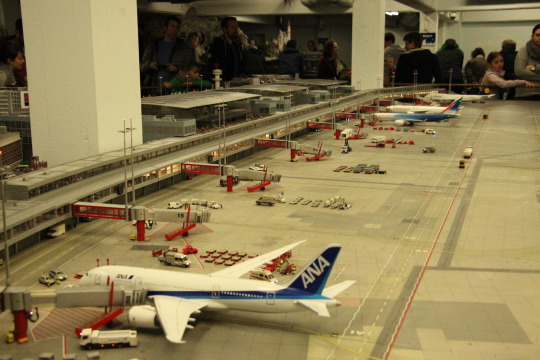


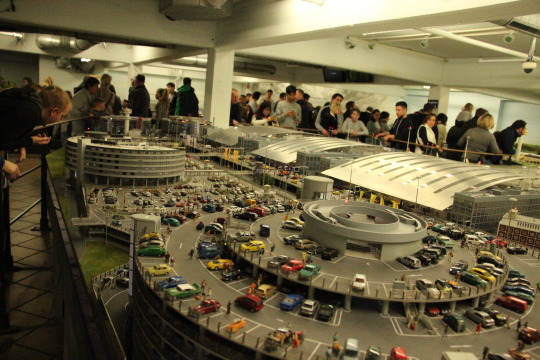
Looking back, this place was so realistic and so well thought out, I wouldn’t have surprised, nor mad had the miniature people actually started moving. Ugh.
I just.
I. JUST.
I went to bed the happiest of Nigel’s that night.
Alas, all good things must come to an end, and the next day, I flew back to Paris and caught my train back to Nîmes. But! Obviously not before I made my way to Chipotle, and ended up getting a FREE burrito because the French are apparently yet to have mastered the fine art of wrapping a burrito that’s the size of a newborn child. I must admit, I doubt it’s an easy skill to learn. Regardless I was not mad about it, y’all! 🌯
Rome
Post-German adventures, after a few days of relaxation and tutoring in Nîmes, I joined my roommate Carrie and her friend Dom (a different Dom than last time!) halfway through their own European adventure of Paris, Rome, and ending in Barcelona. When I heard about their plans I figured it’d be a perfect opportunity to finally go to Italy, as I thought it was pretty strange that I studied opera and lived in Europe for two years and still hadn’t been to Italy. What?
So day 1: The Dom, Carrie and Nigel Main Attraction Marathon
On this day, we did all the major touristy, you-have-to-go-see-this-if-you’re-in-Rome” attractions: the Colosseum, the Trevi Fountain, the Spanish Steps, the Pantheon, etc. Carrie’s Fitbit kept track of all our steps and I think this day was our highest!
We did take a break from the marathon tour at one point between sight-seeing. We decided we wanted to stop and just soak up and enjoy the Italian sun and the beautiful weather that had graced our first day. We pulled up our maps and found the Villa Borghese Gardens, a park in the western part of the city and rented one of those multi-person cab/bicycle machines and drove through the park, terrifying everyone around us as we yelled in English from fear of hitting a passing pedestrian... #oops. But no one died, so I call it a successful adventure, and our sight seeing marathon continued afterwards.


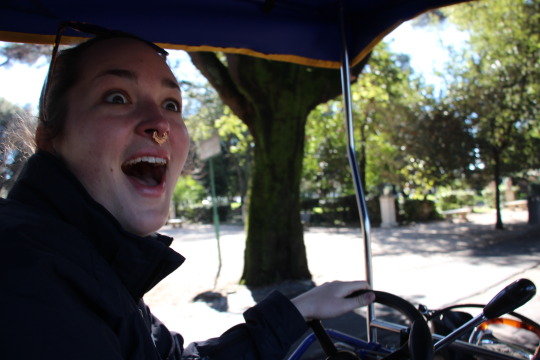
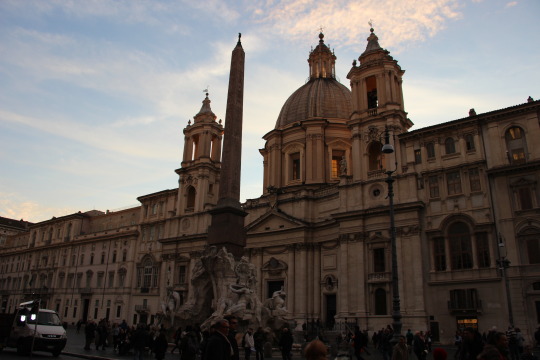
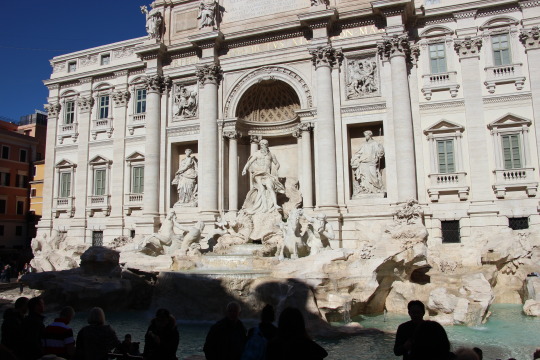
Our dinner plans for each night ended up being very consistent with the exception of our first night. On this night, we decided a little too late to eat, and found ourselves getting to restaurants just as they had closed their kitchens. Carrie, however, came to the rescue with her favorite restaurant in Rome (she’s been to Rome about six times and knew the good places to go), that she had been saving for our last day. She had somehow (read: drunkenly) made friends with the owner of the restaurant, and even though it was about 6 years ago, they still remembered her and were always overjoyed to see her whenever she came back.
The food was, of course, delicious. All three of us ordered the Cacio e Pepe, which is basically spaghetti in a spicy cheesy sauce, and what blew my mind was that they literally made the pasta in the restaurant while we drank the wine and waited! What?! Maybe it’s common practice in Italian culture, but I couldn’t believe it!
The next day, Day 2 in Rome!, we all went to our separate corners for most of the day. Dom, who was doing her very first European trip, and who had been sick while in Paris, needed a day to recover; Carrie, being the health-nut that she is, went on a very long run and if I’m not mistaken got very lost; and I grabbed my bag and my camera and kinda just wandered around the city for a few hours. We met up later for a group wander around the city, but didn’t see anything too exciting (relatively speaking of course, this is Rome we’re talking about). But as dull as Day 2 might seem, it was the night we had our first Italian aperitivo which we ended up doing this every night for the rest of the trip because of its genius. It’s basically like the American happy hour, but with a brilliant twist: it’s 10€ for one glass of wine or cocktail as well as an all you can eat buffet that’s unique to each restaurant. GENIUS. This ended up being a fantastic way to go to a variety of restaurants without breaking the bank and might be one of the things I miss the most about Rome.
Day 3 in Rome! was what most people would consider the big day if you’re in Rome: we went to see St. Peter’s Basilica and the Vatican and its many, many, many museums. It goes without saying that everything was beautiful. And even more beautiful, the longest wait we had was only about an hour and a half! True perks of sight-seeing during the off-season! It was so uncrowded, that we actually walked straight into the Vatican museums, no lines, no wait! Carrie, having been to Rome multiple times, said that she had once waited for 4 hours to get into the museums and was stunned that Dom and I just waltzed in as if we were going to Target. Carrie also, citing that she had been multiple times, declined to join us into the museums. I didn’t understand at first, especially since she had already toured the Colosseum with us, but it didn’t take long for me to get the picture.The Vatican Museums have just an insane amount of artwork, having been in the process of collecting over centuries by the various Popes. I can only imagine that after waiting in line for up to 4 hours, walking around and trying to absorb the thousands of pieces of art for another 4 hours would be nothing less than exhausting.
Dom and I decided to leave the Sistine Chapel for last, knowing full well that if we started there, we’d probably just leave afterwards 😂. And of course, not being art buffs as well as already feeling the past 2.5 days of walking in our feet, were not stopping to admire every single piece, so we had what I’m sure a lot of other tourists would consider a speedy pace through the museums, and yet it still took us about 3 hours.
So now, here’s a point where I realize, as I type, that there’s a potential for an #unpopularopinion: I was rather underwhelmed by the Sistine Chapel.
Lemme explain.
Every time you hear about the Sistine Chapel or see anything about it, you see or hear about The Creation of Adam, so I thought that that painting would be the main focus, or the biggest part of the ceiling. I was quite mistaken. While it is very much in the center, it was the same size as the rest of the paintings, and it actually took me a hot second to find it! All that said, the Chapel (as well as the entire Vatican and its museums), was breathtaking, but definitely does not look like it does on the box... I guess what I should say is that I was going into the experience expecting something very, very different.
But so okay, world renowned piece of culture and art officially checked off my list! Woo!
Carrie, again with her traveling prowess, had compiled a list of restaurants that we had to try while we were there, and so after St. Peter’s Basilica, but before the museums, we went to check one out. Usually, the list had details about the restaurant listed such as recommended dishes, best times to go, etc. but the restaurant we went post-Peter, Bonci, had only one thing written: GO. Knowing Carrie, this was no joke, and sure enough, it wasn’t.
Bonci is a “pizzarium” that uses all natural ingredients and makes handmade pizzas. It was a “street restaurant” and so once you had your pizza, you sat outside and enjoyed the Roman sun while your mind was absolutely blown by the delicious pizza. The pizzas they make are very square (literally, not metaphorically), very large, and basically in HD. I’ve never seen so many pizzas in so many bright and vibrant colors that all looked so good. Needless to say, I got seconds...and then went back the next day for thirds.
The next day, Day 4 in Rome!, we three musketeers disbanded yet again for the morning and went our separate ways for a few hours. I had found an article online about interesting things to do and see off the beaten path in Rome, and read about a canon that’s apparently fired everyday to signal that it’s noon. This is apparently done to help all the churches and cathedrals in the city know the exact time so they can set their bells to toll at the same time. When I got to the top of the massive hill, sweaty and dehydrated, I was surprised to find a sizable crowd there, and even more surprised to hear that the majority of the crowd was made up of Italians. They were all lined up along the edge of a hill and at the bottom was the cannon and three soldiers. Out in the distance was a gorgeous panoramic view of Rome that really took my breath away. But so, the cannon was indeed fired, and my ears indeed started to ring because I was, indeed, standing too close to it. #oops. But alas, that was my last day in Italy, and after another night of aperitivo, the next day I was on my plane back to France, while Dom and Carrie continued on Barcelona. And, yes I was, indeed, jealous.
Rotterdam
So if you haven’t gathered the idea yet, I really, really, really enjoy the Netherlands, and decided after visiting this summer that I’d go as often as possible while doing TAPIF. Something about the culture and of course the friends I’d made there make every trip I’ve made so far just incredibly successful, and this time was no exception.
Well, there was actually one exception to this non-exempt trip: to keep things cheap, I usually take the TGV from Nîmes to Paris, and then take an 8 hour bus ride from Paris to Amsterdam. For some, 8 hours is entirely too much, but to me, after having done 8 hours to and from CT and Pittsburgh in college, it was quite run of the mill, and even better, the bus from Paris to Amsterdam is usually relatively empty and quiet. On this trip however, that was not the case.
First off, I don’t know WHAT was going on with the bus driver, but homeboy could not drive in a straight line and we literally swerved from one side of the lane to the other the whole way from Paris to Brussels. But, in reality since it was a giant coach bus, we were actually swerving from one side of our lane to the other side of the lane next us. We finally stopped in Brussels and thankfully changed drivers, but now the bus was suddenly full of people. I, somehow, miraculously, still had two seats to myself. So, as the bus started to roll along, I put my headphones back in and let most likely Beyoncé sing away the next however many hours...until I heard that dreaded sound. The sound of logs being sawed in half, the sound of a manual car’s gears grinding as you fail to shift gears, the sound of a motorcycle idling at a stop light: snoring. LOUD snoring.
I took out my headphones in disbelief that someone’s lack of nasal strips could penetrate the beauteous sounds of my Queen🐝 , and I turned and saw a dark-skinned, heavyset man in a very bright yellow shirt, mouth agape, eyes shut, sounding like he was leveling a FOREST.
So, to give you some context, I really hate snoring. Like really, really, really hate snoring, and become irrationally angry irrationally quickly when I have to sleep in a room with someone who snores. In my sleep deprived mind, I get so jealous that they get to sleep while I get to SUFFER. But this time, I wasn’t even trying to sleep, and I learned I don’t just hate snoring when I’m attempting to sleep, but in more of a general sense, in any and all forms. Thankfully, my stop, Rotterdam, was before Amsterdam, so I didn’t have to spend the entirety of the remaining bus trip contemplating violently shaking the man awake. I may be used to 8 hour trips on the road, but I have limits, y’all!
All snoring aside, this trip to the Netherlands, while successful, was definitely much more relaxed than my last three. I stayed with my friend Gert-Jan, the founder of the queer youth center The Hangout010 in Rotterdam whom I met this past summer. When I arrived, I went straight to The Hangout and had some dinner and caught up with Gert and some other friends, and happened to have arrived while some American college students were visiting Rotterdam and The Hangout while studying abroad. We had a really engaging conversation about sexuality and gender and then went to grab some drinks at a local gay bar.
The next day was a true Nigel day: I wandered around Rotterdam for a few hours and grabbed some lunch at the Markthal, took the train to Amsterdam and then just wandered around my favorite city until it was too cold to be outside (and I of COURSE went back to the Foodhallen and spent entirely too much money).
On day 2, I visited my Couchsurfing host from my last Dutch excusrion to Leiden, Christiaan, in Deventer, a very cute little town in the eastern part of the country. It was filled with quirky little shops, including some that sold model trains (that I somehow refrained from purchasing), one that only sold stamps, and another that had three or four enormous trays so full of postcards that I thought they were selling CDs. They had postcards of literally anything you could think of: animals, people, naked people, buildings, trains, chairs, beds, anything and everything. Needless to say, I got one from the train section.
After our mostly window shopping, Christiaan and I went back to his apartment and were thinking of what to make for make dinner, and decided on ginger pumpkin chutney with some cheese and bread, as well as pumpkin curry that ended up being a lot better than I thought it would! The chutney, too, was outstanding, and within a half an hour, both were completely demolished.
I got back to Rotterdam late that night, and the next day, unfortunately had to leave until who knows when! 😫 😖 😭
The Journey Home
“Nigel, why in the world would you write about the journey home, it couldn’t have been that exciting.” I know, I know, but this one ended up being really funny! (And also the source of the title 😉 ).
Well I got on the bus in Amsterdam. I sat down. A very handsome man sits down next to me (and was I mad about it? Y’all know I was not!). But, as it was 8.45 in the morning, I didn’t really try to strike up a conversation.
Until!
I realized I had left all the food I had for the trip in my bag which was now in the overhead bin. Not thinking, I asked him in English if I could get out and he looked at me in shock. As it turned out, even though he was indeed French, he had spent a year abroad in California, and had been dying to find an American with whom he could practice his English. His name was Cyril. We got to talking and I heard about his time in SoCal and I told him about my being a teacher blah blah...and then we got to talking about what we were doing in the Netherlands. We had both only gone for the weekend, and both had gone for the sake of seeing good friends. And then, almost to himself, he mentioned that the bus ride to Amsterdam had been awful. I commented that mine had been pretty awful too, the worst part being the snoring man...Cyril stopped me: “was he like a bigger guy with a really crazy bright yellow shirt?” I looked at him curiously...and asked him if the first bus driver had been just completely incompetent at driving in a straight line, and it was confirmed: we had been on the same bus! We laughed about it for a while and once we got to Paris, we exchanged Facebooks and went our separate ways.
For the train ride home, I was hoping for a quiet ride so I could write this blog post. Just as the train was leaving, I realized no one had sat down next to me, and was very thankful for the extra space, and settled in to recounting my adventures. But then of course, a woman sits down next to me. Womp. Oh well, I told myself, no biggie. So I try and get some typing done until I realize, this woman is fiddling with a very thick and very long, purple rope. What? I do my best to inconspicuously see what it leads to, but with no luck. Until the other end of the rope suddenly...moves! It was a dog! And a beautiful one at that. Now again, as is the case when I see any dog, my mind just shut down and I started speaking to her in English about her dog. Thankfully, she was American too, and we talked the whole ride down.
Yvette, I learned, was from Colorado (Denver, I think) and just so happened to also be doing TAPIF in a town called Béziers, not too too far from Nîmes. We gabbed about life abroad and what is was like to be a teacher (she’s a primary school teacher, too) and so on. Eventually, her dog, Kaya, got tired of being on the floor in the aisle and decided she’d be more comfortable between Yvette and myself which I, of course, had no problem with. I asked her what it was like to have your dog with you while living abroad, and Yvette explained that, while it certainly had its perks, it could be frustrating when it came to traveling: the TGVs never had enough space for everyone’s luggage let alone a dog, and keeping an eye on the dog proved to be difficult when your eyes are seeing the sights:
“I have to be very mindful of her when we go sightseeing,” she told me. “I’ve realized that Kaya has a tendency to pee on things that are older than America. We went to some ancient church in Béziers, and I looked up to admire it, and then looked down to see Kaya peeing on it.”
Needless to say, I cackled and promptly retitled this blog post.
Alas, that was the last day of my vacation. Since then, it’s back to the grind here in Nîmes with teaching and tutoring in full swing. The weather has been absolutely gorgeous as the perks of living the south of France have made themselves apparent with 60º+ weather and days full of sunshine.
Et c’est tout! Thanks to those who read all of my ramblings, this one in particular was a doozy, but I really appreciate it! Next post(s) will be hopefully a trip to Portugal and Madrid for April vacation (omg I’m so excited I can’t even, I can literally only odd), and maybe a weekend trip or two during the vacation-less month of March!
Until next time!
0 notes
Text
Why are Thailand’s roads among the deadliest in the world?

The Thai woman was riding on a motorcycle on her way to work when a pickup truck sideswiped her on a rural stretch of asphalt in northeastern #Thailand. The truck’s driver was an off-duty police officer. He was drunk.
Orathai Chanhom, the motorcyclist, was catapulted off her bike and killed almost instantly in the crash. The officer who struck her still has his police job. His driver’s licence was not taken away. A court declined to sentence him to prison. In Thailand, one of the world’s most unequal societies, even its roads have a rigid hierarchy, with the poor far more likely to be killed in accidents than the well-off and well-connected. And there are many deaths: Thailand had the world’s second-highest rate of road fatalities per capita, surpassed only by war-afflicted, lawless Libya, according to a 2015 report from the World Health Organisation (WHO). When it comes to per-capita motorcycle deaths, the country is number one. The government vowed at a United Nations forum in 2015 to halve the number of road traffic deaths by 2020. With less than one year to go before the deadline, however, Thailand is a long way from fulfilling that promise, its roads still ranking among the world’s 10 most dangerous, with more than 20,000 preventable fatalities a year. The country has seen a small dip in road deaths since 2015, and Thailand has in place many of the necessary laws to make its roads safer. But what the government has not addressed is the country’s vast gap in wealth, which is the core issue that not only makes its roads so deadly, but has also split the country into two bitterly divided political camps: Thailand’s haves and have-nots. Thailand, named the most unequal country of the 40 major economies surveyed last year by Credit Suisse, has what might be the world’s most toxic combination for traffic safety. Unlike poorer countries, its roads are well paved and made for speed, and the cars driven by the rich and its growing middle class tend to be new and fast. https://bangkokjack.com/2019/08/12/thailand-reduce-road-accidents-aim/ But many Thai families can only afford a single scooter or motorcycle, and high-quality helmets are a luxury for many, whatever the law says about them being mandatory to wear. In accidents on the country’s crowded roads, it’s a devastating mismatch when an air-conditioned SUV collides with a two-wheeler, scattering the detritus of death across the asphalt. And the aftermath of such accidents are a common, macabre sight on Thai thoroughfares: a shredded tyre, a mangled frame of steel, a bloody plastic flip-flop. Motorcycle accidents can involve a number of fatalities. Because public transportation is limited outside the big cities, it’s not uncommon to see a couple of adults – and even a child or two crammed between them – balanced on a single bike. Only 12 per cent of Thailand’s road traffic deaths involved occupants of cars or other light vehicles, according to the 2018 WHO Global Status Report on Road Safety. Most of the dead were motorcyclists – or pedestrians. In many Thai towns, there are few wide, easily usable pavements because, critics say, they are not a priority for the rich and influential, who prefer not to walk in Thailand’s oppressive heat. When there are wide footpaths, they often overflow with street stalls and even motorcycle traffic, pushing people into the roads. The country’s economic disparity is not the only reason Thailand’s road deaths are not distributed equally. Justice, too, is handed out unevenly. For the super rich, or those in positions of authority, the rules of the road may not apply at all. They know they can speed with impunity and drink heavily before getting behind the wheel, with little fear of the consequences. In 2012, a young man in a Ferrari – the heir to the Red Bull energy drink fortune – allegedly ploughed into a policeman, dragging him to his death. The driver, Vorayuth Yoovidhya, was intoxicated, according to a test. Seven years later, he has never been prosecuted. “What is clear in Thailand is that the roads are not safe for all users,” says Evelyn Murphy, who specialises in unintentional injury prevention at the WHO. “Whether it’s cars or motorcycles or pedestrians, the safety of all users of roads must be considered, regardless of income level.” https://bangkokjack.com/2019/08/10/thailand-reduce-road-accidents/ Weak enforcement, compounded by corruption Speeding, drunken driving and failing to wear proper helmets are the primary causes of traffic deaths in the country, Thai officials say. While the laws are there to combat each of those factors, enforcement is not. Wearing helmets is required on two-wheelers, but fines are rarely issued, unless the police need to meet a specific quota during a crackdown period. Unaccustomed to checkpoints or sirens, speeders or other rule-breakers may not even pull over when caught. “It’s hard to convince people to stop for us when they are not used to stopping,” says Jirasunt Kaewsaengeak, the deputy commissioner of the Bangkok Metropolitan Police. Then, there is corruption. The rich or well-connected know a bribe can often see them on their way if they are nabbed breaking traffic laws. Bangkok’s 3,000 traffic police make an average of £500 a month for working in broiling heat, monsoonal downpours and suffocating smog, which can make even small payoffs highly appealing, and effective. Twice a year, during the Thai new year in April and the western new year in January, campaigns warn against drunken driving, complete with billboards of gory crashes. Arrests skyrocket during these periods, but then quickly fall off again. “If you eat vegetables twice a year and only eat ice cream for the rest of the year, your doctor will think you are crazy,” says Tairjing Siriphanich, the secretary-general of the Don’t Drive Drunk Foundation of Thailand. “But that’s what we are doing with road safety.” A ‘sabai sabai’ mindset When asked why so many people die on Thai roads, officials here ascribe it to a “sabai sabai” culture. Sabai sabai is one of those untranslatable phrases, but it denotes a kind of relaxed contentment. Sabai sabai is one reason Thailand is a great place for a beach holiday. But it’s not a helpful attitude when building national safety standards. “If police enforce the law, rather than just give a verbal warning, then Thai people are unhappy, and they complain that it’s not sabai sabai,” Jirasunt says. A prime example of the effect of the sabai sabai way of life on traffic safety is the approach to helmets. Many motorcyclists simply don’t bother. “People think air pollution is a threat, but they don’t think the same way about drunken driving or wearing helmets,” says Tairjing of the Don’t Drive Drunk Foundation. “We have failed to make people understand that they can save their own lives.” But the authorities can make a difference: in the districts where police are known to hand out fines, helmets are more common. The government could also do more to educate Thais about helmets, which are often substandard or worn incorrectly. “When you see someone who makes the effort to put on a helmet without actually strapping it on, it defeats the whole purpose of wearing it,” says Murphy of the WHO. “It shows a lack of understanding of basic safety mechanisms.” https://bangkokjack.com/2020/02/18/fewer-road-deaths-songkran/ Shifting the blame In 2016, 32.7 out of every 100,000 Thais died on the country’s roads, according to the most recent WHO estimates. By comparison, the road fatality rate in the United States was 12.4 that year. In Indonesia, a less-developed southeast Asian country with more potholed roads, the rate was 12.2. Across most of Europe, it was a single-digit number. Since the government made its promise to halve road deaths, a vow other countries have also made, Thailand has barely inched upwards, moving from the country with the next-to-worst per-capita death tally to the ninth worst. “No political party has made this an issue. No leader wants to do anything,” Tairjing says. “They just make promises to halve the number of road deaths even though they know it’s impossible. Maybe they think we’ll forget about the promises they made.” The question of who is at fault for Thailand’s lack of progress draws a lot of finger pointing by Thai officials. Chayatan Phromsorn, the deputy director-general of the Office of Transport and Traffic Policy and Planning, the agency that pledged to the United Nations to halve the number of road deaths, said he was not familiar with the document that detailed Thailand’s promise. (That English-language document was never made available online in Thai script.) The official who presented the paper to the United Nations in 2015 said she had done so only because her colleague was unable to attend the conference. In turn, that colleague, Usanisa Jikyong, said in an email that her office “is not responsible for a road safety initiative in the national level”. Usanisa suggested that another government agency, the department of disaster prevention and mitigation at the Ministry of Interior, was in charge of such matters. But Chayabol Thitisak, the department’s director general, shifted responsibility back to Usanisa’s office. Officials at both agencies said that the blame lay primarily with the police. “The big factor is law enforcement,” Chayabol said. “We have to make people realise that by violating the law they will face severe consequences.” But the police refuse to accept fault. “As police, there are many things we cannot do,” Jirasunt says. “We cannot build more roads and public transportation. We cannot change the number of cars on the road. We cannot change the attitudes of people so they have discipline.” The high human cost The World Bank estimated in a 2018 study that Thailand could lift its per-capita gross domestic product by 22 per cent by the year 2038 if it successfully halved its traffic fatalities. Despite that economic upside, the government – led by a retired military general since a 2014 coup – has done little to address the wealth gap that’s at the core of Thailand’s problem with road deaths. The country has made a few road-safety improvements. Schools have added road-safety lessons to their curriculums, and there has been some progress in setting new vehicle safety standards. The numbers do show a slight improvement: road deaths were 7 per cent lower in 2018, with 22,491 deaths compared with 24,237 in 2015. While the enormous macroeconomic cost of all these road deaths can be measured, what can’t be given a money figure is the personal toll inflicted on individuals by the inequality and impunity that menaces Thailand’s roads. The family of Orathai, the killed motorcyclist, has no lawyer to pursue a civil claim. It did not appeal the decision not to jail the officer. There is no further legal action to take. “In Thailand, the law does not matter,” says Chularat, her daughter. “People like us, how can we change anything? Even if we die for no reason, our lives are worthless.” For the poor, Thailand’s roads are unsafe at any speed. – You can follow BangkokJack on Twitter, Instagram, & Reddit. Or join the free mailing list (top right) Please help us continue to bring the REAL NEWS - PayPal Read the full article
0 notes